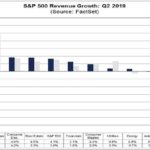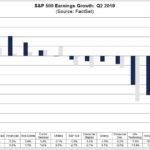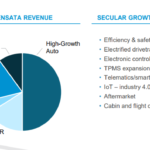Apple reported better than expected revenue and earnings, with revenue of $53.8B vs $53.4B expected and EPS of $2.18 vs $2.10 expected. Revenue was up 1%, returning to growth, despite 300bps headwind in the quarter from currency. They also issued guidance above the street with a range of $61B-$64B for Q4 – the street was at $61B. They are making progress on diversifying away from the iPhone. This was the first quarter in many years where the iPhone represented less than 50% of revenue. They saw an impressive 48% growth with their “Other Products” business on robust wearables growth (e.g. Apple Watch). A return to revenue growth in China on a constant currency basis was a big relief given sharp declines in the last couple quarters. Services, however, were a slight disappointment at $11.5B vs consensus $11.8B – that represented 13% growth. Services is a key part of their long-term story and is higher margin. The next couple quarters will be important for the Services segment as they launch Apple TV+, Apple Arcade and Apple Card.
Key Takeaways:
· Performance in China was a key positive – they returned to growth on a constant currency basis. Last quarter they reported China revenue down 22%.
· iPhone revenues (-12% YoY) were a little light vs expectations after beating last quarter.
· Revenue excluding iPhone was up 17% from last year with growth across all categories.
· Mac sales were better than expected after weak performance last quarter. Mac and iPad sales grew 11% and 8% YoY, respectively, when broader notebook and PC market declined YoY in 2Q
· Services revenue decelerated from 16% growth last quarter to 13% growth. However, excluding a one-time item from last year and Fx headwind, currency neutral Services growth was 18%. Management reiterated their target of doubling FY16 Services revenue in FY20. Accounted for ~21% of sales and ~1/3 of gross profit.
· Paid subscriptions grew by 30M+ in F3Q19 to over 420M.
· Apple recently announced a $1B acquisition of Intel’s smartphone modem business to further their long-term strategy of owning and controlling the primary technologies behind key products. This could reduce reliance on 3rd party vendors and help Apple differentiate and expedite the development of future products. Qualcomm, who Apple had been in a long legal battle with, dominates the baseband processor market – they design the chips that allow smartphones to connect with data networks. Qualcomm was Apple’s supplier, then b/c of the legal battle they moved to Intel, now they’ll be using Qualcomm again for 5G chips, but this acquisition signals more in-house design long-term. Apple already designs in-house the processor chips (their A12 Bionic chip) that are the “brains” of their phones, iPads etc.
Valuation:
· Trading at about a 1.4% dividend yield, and >6% FCF yield.
· They have about $102B in net cash on the balance sheet. That’s over 11% of their market cap.
· The stock is undervalued and substantial buyback from management’s goal of net cash neutral will support valuation.
· In addition to the >$100B in net cash they already have, they produce about $60B in FCF annually. That’s more than all the other FAANGs combined.
· In Q3 they returned $21B to shareholders through $17B in share repurchases and $3.6B in dividends.
The Thesis for Apple:
- One of the world’s strongest consumer brands and best innovators whose product demand
has proven recession resistant.
- Halo effect -> multiplication of revenue streams: AAPL products act as revenue drivers
throughout portfolio – iPhone, iPod, MacBooks, iPad > iTunes, Apps, Software, Accessories,
- Strong Balance and cash flow generation.
- Increasing returns to shareholders via dividends and buybacks.
$AAPL.US
[tag AAPL]
Sarah Kanwal
Equity Analyst, Director
Direct: 617.226.0022
Fax: 617.523.8118
Crestwood Advisors
One Liberty Square, Suite 500
Boston, MA 02109
www.crestwoodadvisors.com




